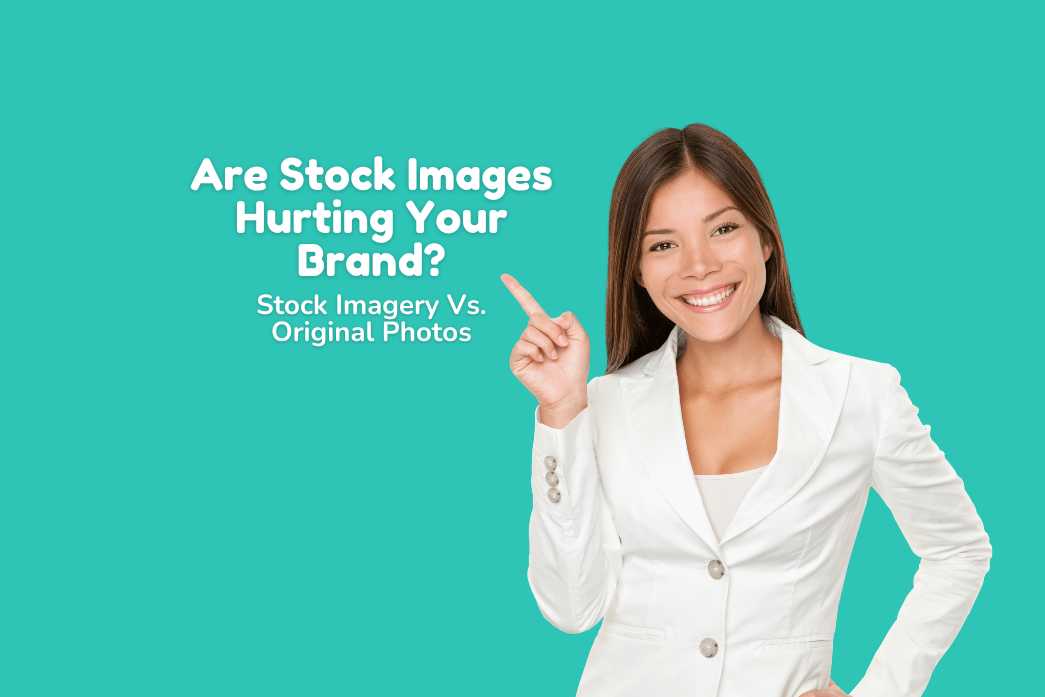
It’s hard to avoid stock images. Even if your business has a bank of original photos, you’re likely to turn to stock for a relevant article feature image, display ad asset or organic social post. But it seems they’re increasingly putting users off.
Have you ever seen the same royalty-free image you used last month on a competitor’s website and sworn under your breath? Are you in a battle with your finance team to commission some original photography? Do you simply not know what your other options are? This blog post is for you.
We’ll start by explaining how stock imagery affects user psychology and share some stats, then we’ll look at the issues with using stock photos and how you can avoid them (even while using stock photos!). And finally, we’ll explore the alternatives.
Stock Imagery & User Psychology
User Experience Researcher Jakob Nielsen ran eye-tracking tests to find out how people respond to images when browsing online:
‘Some types of pictures are completely ignored. This is typically the case for big feel-good images that are purely decorative. Other types of pictures are treated as important content and scrutinized. Photos of products and real people (as opposed to stock photos of models) often fall into this category.’
His overwhelming finding was that people only pay attention to images that tell you something. And it’s quite hard for stock images to tell you things. They won’t tell you who works at the company, what the actual products or services look like, or why you should use the business.
They can communicate some things, of course. The content of an article or the personality of a brand. The emotion you’re supposed to be feeling.
But there’s still an unavoidable problem. The user subconsciously categorises the image as a stock photo. A fake photo. A filler photo. And ignores it.
When they see the image and close the tab
So why can a user ignoring your photo hurt your brand?
One image might be slowing your website down and taking up space – another image might have nudged the user towards a conversion. But the bigger problem is when a user fully pays attention to an image, and it negatively affects their perception of your business.
The way a user reacts to a stock photo is hugely dependent on the type of business, the context and the image selection.
- Type of Business: Users especially dislike seeing stock images on eCommerce sites. They can break down trust as it may not be clear if the photo contains your products or not. For many service businesses, stock images are more common, and the user’s reaction will depend on the choice of image.
- Context: Don’t use a stock image as if it’s real. Pictures of models on your team page or DEI statement aren’t a good look. A stock image of a hamburger on an Instagram post about hamburgers (from a brand that doesn’t sell hamburgers) – fine.
- Image Selection: If it’s not a hamburger, cut the cheese. You can probably tell the stock images that look embarrassingly stocky from the ones users won’t cringe at. Put time into finding photos that fit your brand identity and carry authenticity.
The data
Venngage surveyed a bunch of marketers. 39% said that stock photos were their worst-performing visual assets … but 34% said they were the best. They also found stock photos were the second most used type of visual content, behind original graphics.
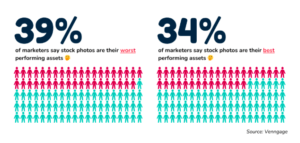
It goes to show that it’s all about context. But are so many marketers using stock photos because they perform well – or because they’re easy? A third of the respondents said that producing visual content consistently was their biggest struggle when it came to content production. So it’s no surprise that businesses are relying on the stock image.
In a survey by ReferralRock, marketers were asked to rate the efficacy of images in communicating what a brand stands for. They gave stock images 5.76 out of 10 and original images a whopping 9.33.
Even though original images scored higher for performance, the most used source of visuals among respondents was royalty-free images from sites like Pexels and Unsplash.
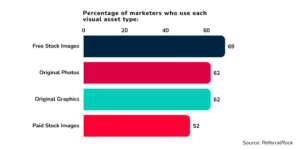
According to Photutorial, there are 2.3 billion stock photos available online. The stock photography market is valued at $4.2 billion in 2024 and is expected to grow to $6.7 billion by 2030. The marketing industry knows that stock photos aren’t the most effective, but it has no plans to stop using them.
The problem with stock
We’ve seen that stock images perform badly from a UX (user experience) perspective, fail to convey your brand and compromise your marketing performance. But why?
Clichés
The first problem is that it’s easy to use generic, cliché images that give off an air of cringe. There are a lot of brilliant and interesting stock photos out there that could expand or subvert the norms of your industry. But how do we find stock images? We search. And the algorithm brings the most generic options to the top.
You can probably guess what three industries the photos below are advertising. That’s not always a bad thing, but the photos are so generic that you wouldn’t want to use the business.
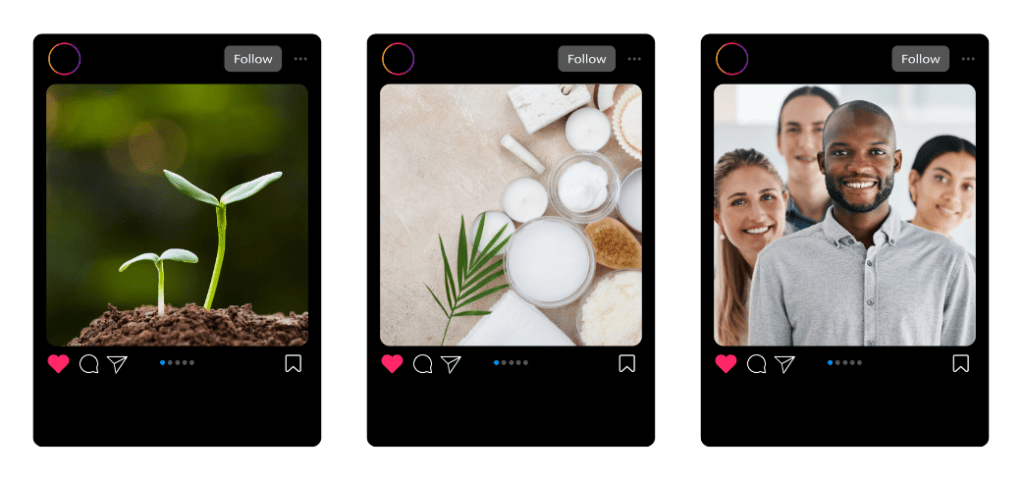
Try searching for stock images differently. Don’t enter obvious image description queries and expect the photo platform to find creative options. You are the creative. Think about exactly what you want to feature and search for it.
Alternatively, build up an image bank for your brand by exploring new images on your favourite stock image sites. When you look at your collection, you can eliminate any shots that don’t fit your brand’s aesthetic and ensure there’s a cohesive look.
Overuse
Another big problem is that a user may have seen the stock image you’re using on countless other websites and social media profiles. This is most often a concern when you’re using free images, but generic searching and lazy selection can put you in dangerous territory, even with paid images.
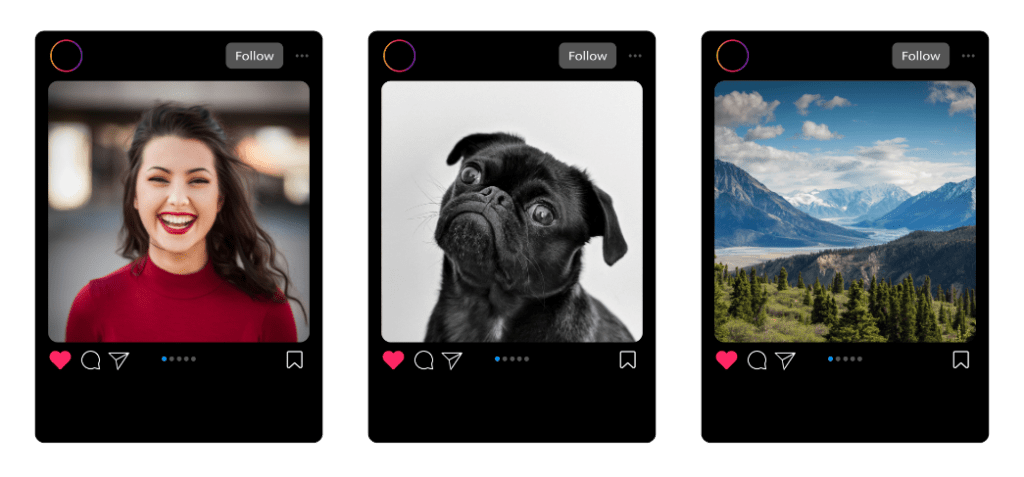
Do you recognise any of these photos? The first has been viewed on Unsplash 236.9 million times and received over 2 million downloads. The discerning pug has been admired by 274.1K Pexels users and the landscape is another in the category of ultra-mass-market stock photos.
When users recognise the stock photos you use, it compromises your business’s professionality and identity.
Generally, we try to use stock photos that haven’t racked up too many downloads. Another option is to customise the image. For a recent social media post, we removed the background from this exact pug photo and popped him on an image of Amazon packages along with a jokey caption about eCommerce. The fact that he’s a popular pug actually helped the post to grab attention.
Remember, context is everything.
Missed Opportunities
The third big problem with stock photos is the absence of original visuals. It’s okay to use stock sometimes, but every business should have original images on its website and marketing channels.
I once saw a LinkedIn post by a career coach who had only used stock photos on her website because she hated to see pictures of herself. When she finally gave in and showed her face on the site, her conversion rate skyrocketed. People made a human connection with her and felt comfortable getting in touch.
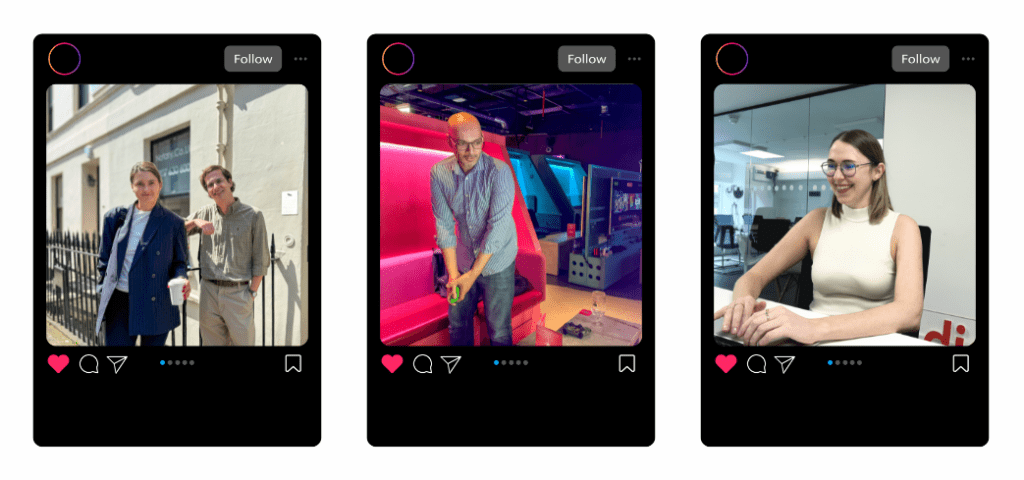
Not every image you put out needs to be perfectly shot and edited. Share some photos of your team, your spaces or your services in action and tell us how much engagement they get compared to stock image posts. We’re confident it will be a lot.
So, is it okay to use stock images?
Good images are essential to marketing success. Forbes reported that people’s ability to remember information after three days goes up from 10% in the case of text alone to 65% when the content is paired with a powerful image.
Images should never be an afterthought. They should be a central consideration in your marketing and website design strategies, with a budget to match. But that doesn’t mean you can’t use stock images. The right stock image in the right context can work hard for your business.
When to use stock images
- You need an image of something specific to support your content.
- You plan to customise the stock image.
- You’re going for a jokey or meme-style visual.
- It’s for aesthetic purposes and fits the brand aesthetic perfectly.
- It’s the best option considering the limitations of your budget.
How to source the best stock images
Naturally, choosing the best stock image sites and paying for photos will get you the highest quality images. But there are many ways to refine your image search powers:
- Take your time. Mark time in your calendar to source images rather than rushing to find something on a task-by-task basis.
- Use precise search terms – and spend as much time thinking about your searches as you do scrolling through photos.
- Explore photos in each stock image site’s ‘Discovery’ or ‘New’ feeds. Many also have great curated collections.
- Ask a member of your team for a second opinion on your image choices.
Alternatives to stock imagery
Many creatives think that all alternatives to stock imagery are very costly, but there are plenty of low-cost and free options out there. Also, the ROI (return on investment) of visual assets is hard to measure, but that doesn’t mean it’s not high!
Professional photography
The idea of hiring a professional photographer might be a bit daunting, but it can be an affordable, one-off activity that benefits your business for years to come.
Don’t overthink it. Reach out to a photographer in your budget who has experience with similar brands. Ask them to come into the office/shop/venue one afternoon. Receive back a collection of high-resolution images suitable for your website, email campaigns, ads and social media – yours forever.
Authentic images (shot by you)
Not all marketing images need to be taken by a professional. In fact, lower-quality, authentic photos often perform best when it comes to social media and email.
Buy a good iPhone and get intentional about capturing moments.
User-Generated Content
Looking for the cheapest and most effective photographers out there? It’s your customers, silly! User-generated content (UGC) refers to images and videos shot by your customers or clients and either posted to social media or sent to you directly. People love seeing UGC because it carries social proof and helps them believe your business is everything it claims to be.
You may be able to source UGC already (always use with permission!), but if you’re struggling, encourage users to send photos engaging with your products or brand in exchange for a discount or an entry into a giveaway.
AI-Generated imagery
Businesses like yours are now using AI to generate unique images that match their brand aesthetic. AI tools like Midjourney, Dall-E and NightCafe let you input a prompt with the subject and style of the image you want.
Be careful when using AI for images. There are a lot of low-quality tools out there, especially the free ones. And as with stock images, you should never use AI-generated visuals which suggest false information about your products or team.
Public domain visuals
When you hear ‘royalty-free’, your mind probably jumps to a picture of a smiling professional or an abstract noun spelt out in Scrabble letters. But there are many images in the public domain that aren’t stock.
Try searching for images of people, places and things on Wikimedia Commons. Or use a Google image search with a usage rights filter.
Graphics
Illustrations, cartoons and artful blobs can have a big impact. Just make sure they communicate something about your content or your brand’s personality.
Important note: stock graphics exist, and many of the same comments from this blog post apply. Try to create original graphics either in-house or by using a freelancer.
Conclusion
Stock photos may be hurting your brand. But not all stock images are created equal. Follow the advice in this article to use them wisely and know when to find an alternative.
Need a hand with your brand’s creative direction? Book in a no-obligation chat with our content team!



